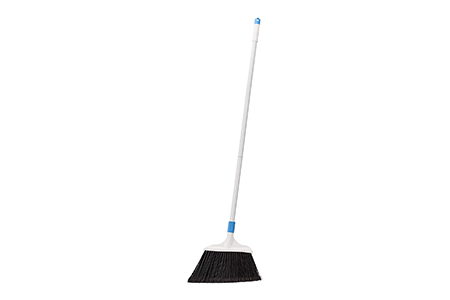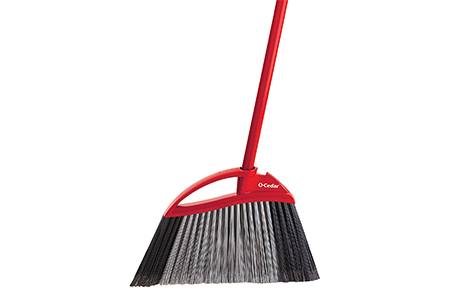17 Types of Brooms to Deal With Every Speck of Dust & Dirt
Author: Anne Cowart | Editor: Omar Alonso
Review & Research: Jen Worst & Chris Miller

No matter how fancy a vacuum cleaner you invest in, nothing comes close to the efficiency and cost effectiveness of the proper types of brooms.
This is especially when you’re trying to get dust and debris off the corners and edges and especially when your floor is a buffet of crumbs thanks to the general eating habits of kids and pets.
Additionally, it really helps that brooms don’t produce any of the din that a vacuum cleaner does.
If you’re thinking of investing in a broom for your cleaning purposes or are already a fan of brooms, the chances are that you’re still going to pick one without much thought.
After all, you just need something to sweep up the dust, right? How does it matter which one you pick?
17 Types of Brooms
Well, it does. You can make your daily chore much easier by picking out the right broom. There are many different types of brooms in the market—you’ll be surprised at the number of options once we break it down for you. Read on.
Soft Brooms

These fan-shaped brooms feature a variety of bristle materials—since they all achieve the same objective, the type of material you pick is left to your personal preference.
Don’t let the ‘soft’ in the title fool you, though—the bristles on these brooms can withstand regular sweeping without bending, thanks to their firmness.
Commonly, these brooms feature corn husks, as these bristles have just the right amount of strength and pliability. The husks are tightly stitched in several rows at one end, which prevents them from wiggling.
Once you get used to maneuvering them, these broom types can last you ages, holding their shape the entire time. The bristles also eventually soften more, which further adds to the ease of usage.
Soft brooms can also be made of grass, among other natural fibers and are much softer than their corn counterparts.
These brooms are very commonly used to clean indoors in South-East Asian countries. Corn brooms, on the other hand, are great for outdoor areas such as patios, garages and driveways.
Hard Brooms

If you’ve got soft brooms, you can bet your bottom dollar that there’s going to be a hard cousin. These brooms, as the name suggests, have harder, stronger, stiffer bristles that are perfect for getting into those hard-to-crack cracks and holes.
These are also great for areas like hearths, where you can’t use any of the types of vacuums but you need to get the dust out.
Hard brooms can be made of synthetic or natural fibers—many countries in South-East Asia use coconut sticks tied together as a hard broom.
Whisk Brooms

Short and small without handles, these brooms are the perfect option if you want to get into a tight space. A dustpan complements these brooms, though you may have to buy one separately.
While these brooms are extremely similar to hand brooms, the bristles on them are made using natural fibers, lending them an organic appeal.
You can even use these types of brooms to clean your keyboards and other nooks and crannies on your devices or sweeping up small bits of fallen food.
Angled Brooms

These modern brooms have won many hearts with their uniquely angled bristles that make it easy to tackle corners and getting around your various types of floor lamps and such.
The bristles, cut at an angle, can pick up just about any debris while sweeping. Made of plastic, the bristles can last you for a long time, staying on the broom till the end of their service.
As it is with soft broom types, the bristles soften with time and become more flexible, which makes sweeping easier and nearly effortless.
Upright Brooms

Upright brooms feature bristles in the same line as the handle, which means that you use them straight instead of angling them to the ground to sweep. These brooms are quite easy to use—your back will thank you, too.
However, as these brooms cover a much smaller surface area, you’ll spend more time sweeping. The long handles may also make maneuvering the broom a bit tricky, but once you’ve got the hang of it, these brooms have a way of making you feel very thankful for them.
Push Brooms

Push brooms are great for covering large areas in one go, with a wider head than most other different types of brooms.
These brooms feature sturdy bristles and are great for sweeping up larger pieces and debris, as minute particles can wiggle through the large proverbial cracks under the bristles and get left behind.
Push brooms are commonly used in restaurants, supermarkets, garages and other areas where you need to clean and clean fast. The bristles on these brooms are generally made of plastic and are meant to last you for years.
Hand Brooms

Hand brooms feature short handles and a dustpan that the broom can snap into—a complete package for sweeping and picking up small amounts of debris or finishing up after using a larger broom.
Small as they are, these types of brooms are not a good idea for large spaces—they’re perfect for spot cleaning, though. These brooms generally feature plastic bristles.
Besom Brooms

If you’re a fan of Harry Potter, Roald Dahl, or even Halloween, in general you’re probably already familiar with Besom brooms.
These brooms have twigs tightly tied around a stick and are more decorative than functional—they don’t last nearly as long as softer, newer brooms and the stiffness of the twigs makes cleaning hard, especially if you don’t want to break or damage the twigs.
Amish Brooms

Amish brooms are bound and sewn by hand and made using high-quality corn straw. Despite their relatively rudimentary, traditional construction, these brooms can last you for years of indoor and outdoor cleaning.
Scented Brooms

No reason you can’t have a broom that cleans efficiently and smells great, right? Scented broom types smell lovely, with cinnamon being the most common fragrance.
Because of this, you can also use scented brooms as decoration alone—if you find one, that is. These specialty brooms may be hard to find, limited to antique or decor stores and boutiques.
While you can use these brooms to clean, bear in mind that they’re more fragile and also smaller than most other brooms.
Corn or Straw Brooms

Corn or straw brooms are the “OG” brooms, popular for being able to cover a large area. However, these brooms don’t work too well when you’re sweeping up dust or fine particles.
Additionally, these aren’t exactly very durable—you’ll probably end up shedding more bristles the more you sweep. Straw, corn, Amish, and whisk brooms are much older designs and I'd venture to say time has moved on and these aren't worth purchasing. They don't hold up to a good broom cleaning, either (yes, you need to clean your broom occasionally).
Therefore, many folks reserve the usage of these types of brooms to the outdoor areas or smaller indoor spaces. They're cheaper and it's not a big deal if they tear up or get nasty over time.
Standard Brooms

Standard brooms are the most common brooms—the ones you buy off the shelf without thinking too much. These brooms are great for indoor spaces that are not too large and are capable of easily picking up any dust and debris.
Rubber Brooms

Rubber brooms are increasing in popularity, as these broom’s bristles could withstand a class 5 hurricane.
They’re nearly impossible to pull out and their strength makes them great for any floor and dirt removal, especially when compared to other brooms.
However, these broom types don’t do too well when it comes to collecting dust. If you’re going to sweep a dusty area, such as near a hearth or under a mudroom bench, then rubber brooms may not be a good idea. especially with weird mudroom bench dimensions that won't allow for the broom to reach underneath.
They do great with dust bunnies and hair though, especially in rooms with any types of fans blowing pet dander and hair around.
Water Brooms

Water brooms are the Model Lagrangian of the broom world—complex. These brooms are used in conjunction with water, in areas where the flooring warrants a wet sweep instead of a dry one, such as in restaurants and kitchens.
Water brooms are great for outdoor areas, patios and garages. Refrain from using them indoors as they can harm your floors, which is why most folks use them only in commercial settings.
Mid-Size Brooms

Mid-size types of brooms, as the name suggests, are a little larger than standard brooms and are great for daily use. They work wonders in corners, along walls and spots that are tough to reach.
Lobby Brooms

Lobby brooms are ideal for situations when you only have one hand for cleaning at your disposal. Compact and lightweight, these are great for spots that are tough to reach, under tables and fixtures.
Wedding Brooms

Rounding off our list a rather sweet addition—wedding brooms. In several areas around the world, wedding ceremonies are incomplete without jumping over a broom.
This tradition is followed in several communities around the world and specifically-designed wedding broom types are made and sold for such occasions.
After the wedding ceremony, you have a broom for cleaning or at the very least, home decor—win-win.
Types of Brooms to Clean Up Any Mess
Granted—the broom is quite a humble tool, but that doesn’t mean you should write it off. Brooms can work wonders when it comes to cleaning and are a great addition to any armory of cleaning tools.
As you can see, there exist many types and while they may each function differently, they all accomplish one common task—making cleaning time much easier.
Investing in a good broom or two is definitely a wise investment for your cleaning needs and with our guide, you can now perfectly pick out the different types of brooms you need.




